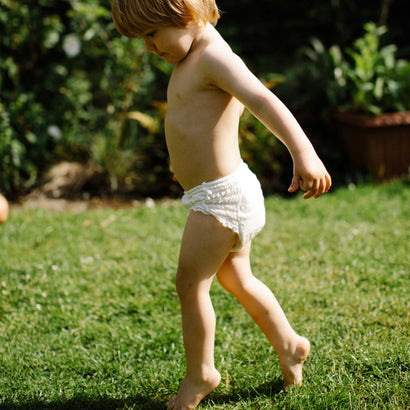It’s 6:30 p.m. and you’ve just wrapped up another busy day—dinner is finished, toys are scattered across the floor, and your toddler has entered that curious stage of energy that defies the concept of bedtime. You know the clock is ticking, but your little one seems to have other plans, whether it’s running laps around the living room or demanding “just one more” story. Sound familiar?
For many parents, the end of the day can feel like the longest stretch—getting your toddler to settle down and transition from playtime to bath time to bedtime is no small feat. But with the right routine in place, that evening chaos can turn into a smooth, calming ritual that not only helps your toddler sleep better but also gives you a moment to breathe and unwind.
Let’s dive into how you can create a bedtime routine that works for your family—one that your toddler will look forward to (yes, really!).
Creating a Toddler Bedtime Routine: With Chart
Establishing a bedtime routine for your toddler isn’t just about getting them to sleep; it’s about creating a soothing environment that helps them wind down and transition into a restful night. Sleep routines for 2-year-olds are vital for promoting better sleep quality and overall well-being.
Research shows that consistent bedtime routines lead to improved sleep duration, fewer night awakenings, and a calmer bedtime experience. Pediatricians often recommend creating routines for toddlers to give them a sense of structure and security. When toddlers know what to expect, they’re more likely to feel relaxed and ready for sleep. So, if you're working on a bedtime routine for your toddler, you’re already on the right path toward better sleep for both you and your little one!
Step-by-Step Guide to Creating a Toddler Bedtime Routine
Creating a bedtime routine for your toddler is simple, but consistency is key. Here's a step-by-step guide to help you get started:
- Set a Regular Bedtime: Aim for the same time every night to help your toddler’s body clock adjust. For a 2-year-old, an ideal bedtime is usually between 7:00-8:00 p.m.
- Start with a Calming Activity: A quiet, screen-free activity like working on a puzzle or drawing is a great way to begin winding down. Bath time can also be a calming transition from playtime to bedtime.
- Brush Teeth and Use the Bathroom: Including hygiene in the routine, such as brushing teeth and using the potty, sets your toddler up for better health and fewer disruptions during the night.
- Dim the Lights: Lowering the lights signals to your toddler’s body that it’s time for sleep. Keep the lights low during the last part of the bedtime routine to create a calming atmosphere.
- Read a Bedtime Story: Choose a short, gentle story to read together. This helps relax your toddler and encourages a love of reading. Snuggling up with a book gives you a special bonding moment while signaling that it’s almost time to sleep.
- Snuggle and Sing a Lullaby: After the story, a few moments of cuddling and a soft lullaby can be the perfect way to end the routine. Keep this time brief but loving, providing your toddler with the comfort they need to drift off peacefully.
By sticking to a bedtime routine for your 2-year-old, you’ll help establish healthy sleep habits that can last a lifetime.

Overcoming Common Challenges in Toddler Bedtime Routines
No bedtime routine is without its challenges. Some toddlers may resist bedtime, experience nighttime fears, or simply have too much energy to wind down. Here are some common challenges and solutions:
- Resistance to Bedtime: It's not uncommon for toddlers to push back when it’s time for bed. Try offering choices like, “Would you like to read Goodnight Moon or The Very Hungry Caterpillar?” Offering small choices gives them a sense of control while still following the routine.
- Nighttime Fears: If your toddler is experiencing fears about the dark or monsters, a nightlight or a “monster spray” (a fun, make-believe solution) can help ease their anxiety.
- Excess Energy: If your toddler is bouncing off the walls at bedtime, consider adjusting their schedule. Make sure they have ample time for active play earlier in the day and start winding down earlier in the evening.
Many parents have found success with these strategies, and combining them with expert tips on managing toddler sleep challenges can help smooth out the rough edges in your bedtime routine.
Benefits of Using a Bedtime Routine Chart
A bedtime routine chart is a simple but effective way to keep your toddler on track with their routine. Not only does it help maintain consistency, but it also adds a visual element that toddlers can engage with.
Here’s how you can create a bedtime routine chart:
- List the Steps: Include every part of the routine, like “brush teeth,” “read a story,” and “go to bed.”
- Make it Fun: Add pictures or stickers to make the chart visually appealing and engaging for your toddler.
- Customize It: Let your toddler help you design the chart so they feel involved in the process.
You can easily find printable bedtime routine charts online, or create your own using simple templates. This chart will not only help you but also give your toddler a sense of achievement as they check off each task.
Recommended Bedtime Activities for Toddlers
Choosing the right activities before bed can set the tone for a peaceful night. Here are some calming bedtime activities for toddlers that you can incorporate into your routine:
- Storytime: A classic bedtime story helps your toddler unwind and enter a calm, imaginative space.
- Gentle Stretching: Simple, calming exercises or stretches can help release any leftover energy and prepare their body for sleep.
- Music or White Noise: Some toddlers enjoy soft, calming music or white noise that helps drown out distractions.
These calming bedtime exercises are designed to soothe your toddler and promote better sleep, ensuring they wake up refreshed and ready for the day ahead.
Expert Tips and Advice on Toddler Bedtime Routines
Experts agree that consistency is crucial when it comes to toddler bedtime routines. Pediatricians often emphasize the importance of starting routines early and sticking with them, even on weekends or during vacations.
Maintaining routines, even amidst busy schedules, will ensure your toddler continues to develop good sleep habits that benefit their overall well-being.
Key Insights
Establishing a bedtime routine for your toddler doesn’t have to be stressful—it’s all about consistency, patience, and making it a positive experience for both you and your little one. A predictable routine helps your toddler wind down, sleep better, and feel more secure.
With a few simple steps, some fun activities, and a bit of flexibility, bedtime can become a peaceful, cherished part of your day. And remember, while routines are important, it’s okay to adapt and find what works best for your family’s unique rhythm.









